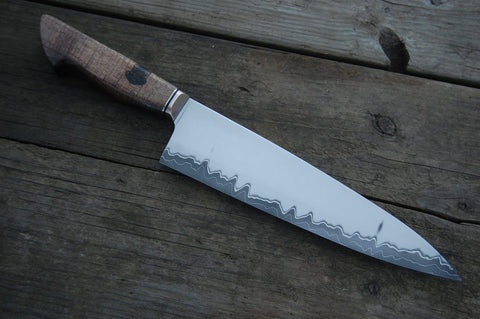SAN MAI what kind of steel?
San Mai, in the context of metal blade construction/metalwork, refers to a knife, blade or sword that has the hard steel hagane forming the blade's edge, and the iron/stainless forming a jacket on both sides. It is also the term used to refer to the technique used to create these blades.
In stainless versions, this offers a practical and visible advantage of a superb cutting edge of modern Japanese knife steel, with a corrosion-resistant exterior. In professional Japanese kitchens, the edge is kept free of corrosion and knives are generally sharpened on a daily basis. Corrosion can be avoided by keeping the exposed portion of the non-stainless portion of the blade clean and dry after each use.
"San mai" roughly translates as three flat things, in Japanese (San=three Mai=unit counter for flat objects). The term, and its root honsanmai, has been used to describe that construction method for many hundreds of years, from around 1300 A.D. It refers to when three layers of steel are used. The center is hard, and the side is typically softer.
Technically, it is a style of lamination used for blade construction, commonly used on blades that have a symmetrical grind (i.e. the edges are ground down from both sides to expose the edge, which is composed of the inner core material. As it is a generic term for a technique, the term can't be trademarked. In Japan, traditionally the steel used for the outer layer is Gukunan-tetsu.
The technique has been used outside Japan in modern knife making in the Russia and United States, often with new types of materials, including D-2 and Carbon Steel.
From Wikipedia, the free encyclopedia.

Photo Haburn(с) Mar 24, 2016



